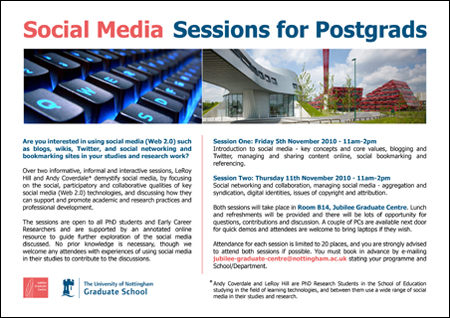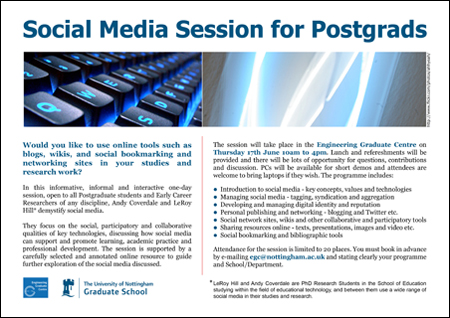A week on from attending the excellent Digital Researcher event run by Vitae and the British Library, it’s been interesting to see how some attendees have followed up with their online activity; developing networks and continuing discussions, partly driven by Tristram Hooley and Alan Cann, two of the presenters at the event. The #dr10 hashtag key has been evident on Twitter, FriendFeed and a number of blogs.
Open online course models, such as George Siemens’ and Stephen Downes’ Connectivism and Connective Knowledge (CCK08 and CCK09) may partly rely on traditional ‘bounded’ online platforms (such as their Moodle site), but actively encourage participants to use their own existing social media (blogs, wikis and social bookmarking sites etc.) for personal reflection, social engagement and content management, as well as creating new groups and platforms for further discussion and knowledge sharing. The use of a unifying hashtag seems at present, the most effective way of aggregating this type of distributed activity.
But how effective is this in sustaining interest and participation? By adopting and encouraging an open, distributed model like this, it is necessary to accept that the resulting activities can be exciting, unpredictable, imperfect, messy or just plain non-eventful.
Attendees at events like Digital Researcher can vary considerably in their awareness, knowledge and competences of the technologies being introduced, and in their motivations to use them (like it or not, some PhD students DO attend training courses just to tick off another skill-set for their annual reviews). The excitement and good intentions which some may take home with them can be soon forgotten in the subsequent days and weeks, as busy schedules and deadlines take over. In addition, people trying social media for the first time often ‘don’t get the point’ of them because their affordances only become evident once a level of maturity is attained.
In the recent sessions I ran with LeRoy Hill at the University of Nottingham, we adopted similar methods of presentation and discussion to those which featured at the Digital Researcher event (albeit on a far less ambitious scale). Though we’ve not conducted any formal evaluation as yet, anecdotal evidence would suggest that the take up of these tools in the subsequent weeks that have followed has been patchy at best. Reflecting on our sessions, we identified that whilst such initiatives can raise awareness, the need to scaffold them with ongoing support such as drop-in open workshops and online discussion groups becomes apparent.
Tristram Hooley rightly points out that students were best supported at Digital Researcher by actively working with each other, sharing personal perspectives and good practice. Arguably, follow-up activities can be scaffolded in similar ways. However, whilst the initial focus can be on the event itself, and within the core group of attendees who are keen to continue participating, that motivation will soon dissipate, as the event and the group become increasingly irrelevant to individual research practices, disciplines and communities. How do we make the transition?



